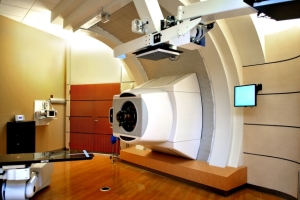Gantryless Room Points to Future of Proton Therapy
by
Brendon Nafziger, DOTmed News Associate Editor | May 10, 2010

New inclined beam
proton therapy room
(Courtesy of ProCure)
A new inclined beam treatment room in Oklahoma points to a cheaper, gantryless future for proton therapy.
Using two proton beams while having a patient strapped to a rotating robotic couch, the room that opened last month in ProCure's treatment center in Oklahoma City can treat many of the patients that a typical proton room could, without requiring the massive, 100-ton gantries that can add numerous zeros to the modality's price tag, according to ProCure. (See also DM 12313 and DM 11475.)
"The issue is not that it's a better solution than a gantry. What we're saying is, it's very cost-effective. And it doesn't compromise who you can treat in a proton center," Dr. Sameer Keole, medical director of the Oklahoma City ProCure Treatment Center and radiation oncologist at Radiation Medicine Associates, told DOTmed News.
The new room is one of four at the Oklahoma City treatment center. In a proton therapy beam room with a gantry, the beam emitter can rotate a full 360 degrees around the patient. But in the inclined beam room that opened in April, there are two beams, one coming in horizontally, at 90 degrees, the other at 60 degrees from the horizontal. Using the robotic couch, the doctors can move the patient relative to the beams, allowing greater coverage.
"We think that can treat well over half the patients, probably closer to 75 percent of the patients that walk into a proton center," Dr. Keole said.
Dr. Keole said rooms with gantries will probably continue to be necessary for pediatric cranial-spinal patients, children who need the entire brain-spinal axis treated. But they'll start moving some adult patients to the new inclined beam room.
CUTTING COSTS
The current cost for a center with a cyclotron to generate the radioactive particles, plus four treatment rooms is about $120 million, according to Dr. Tom Delaney, an associate professor of radiation oncology at Harvard Medical School, co-director of the Center and the medical director of the Francis H. Burr Proton Therapy Center at Massachusetts General Hospital in Boston.
"The issue for the protons is that for protons, you need bending magnets to steer protons 18 times heavier than electrons. The gantries weigh 120 tons, so obviously they're expensive," he told DOTmed.
This capital intensiveness limits the spread of the technology -- there are only seven proton centers nationwide.
"If money was unlimited, you'd build all gantries. It's not, so you want to be careful of over-designing a system that you will never use," Dr. Keole observed. He noted that a new center being built by ProCure in New Jersey, where ground was broken a short time ago, will likely also have one of these gantryless, inclined beam rooms. (See DM 12228.)
While this technology could potentially help the spread of proton beam therapy rooms, Dr. Delaney cautioned that really large numbers of proton beam treatment centers might not be necessary.
"If you look at some of these centers, a third of their patients are prostate cancer patients," he said, which he argued is already well-treated by other techniques, such as brachytherapy. "I think the biggest advantage for protons is going to be some complicated pediatric patients, or complicated spine tumor patients, and those are situations where it remains to be seen whether the new technology can be employed."
Its importance in pediatrics, Dr. Delaney said, is that proton therapy cuts the radiation dose to non-cancerous tissue by 60 percent, which is critical for children because with more years ahead after treatment they have a greater chance to develop a second malignancy. Also, less radiation to healthy tissue means fewer growth problems for young bones.
Read an update on proton therapy in the May 2010 issue of DOTmed Business News, now online.
